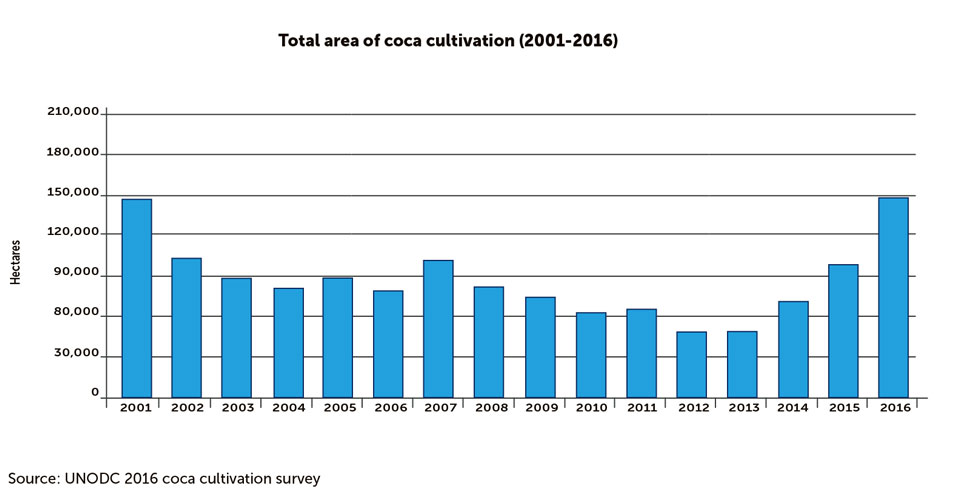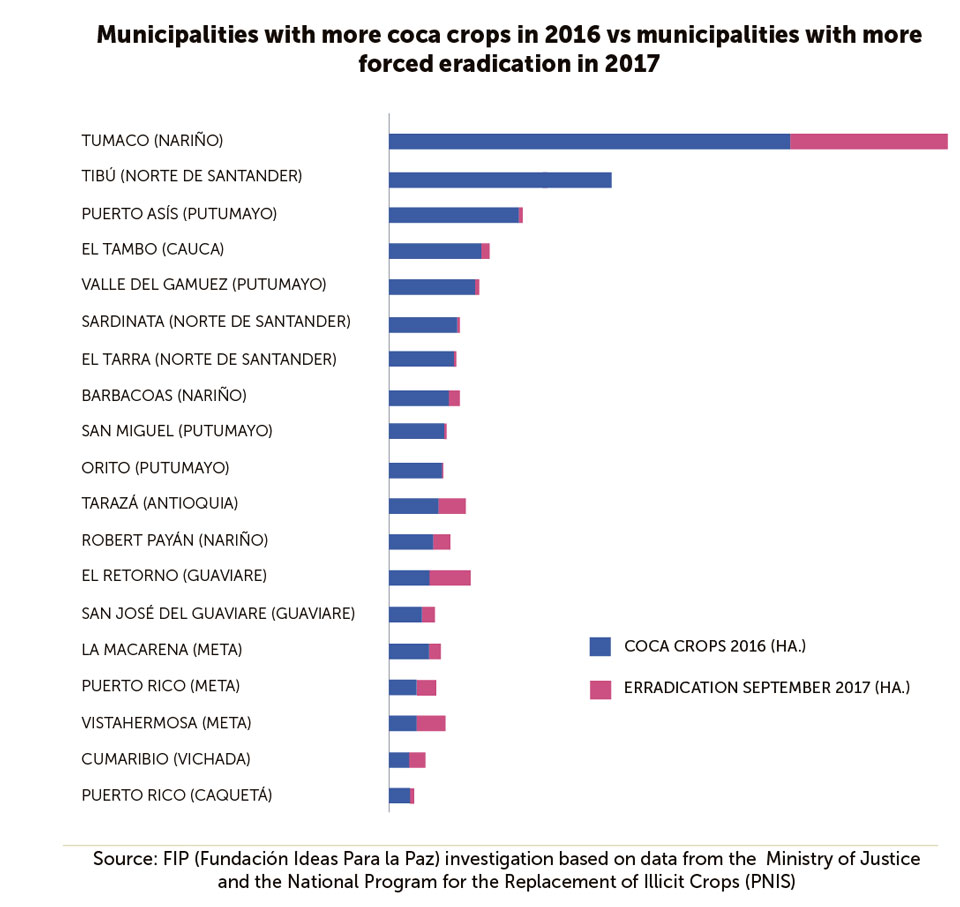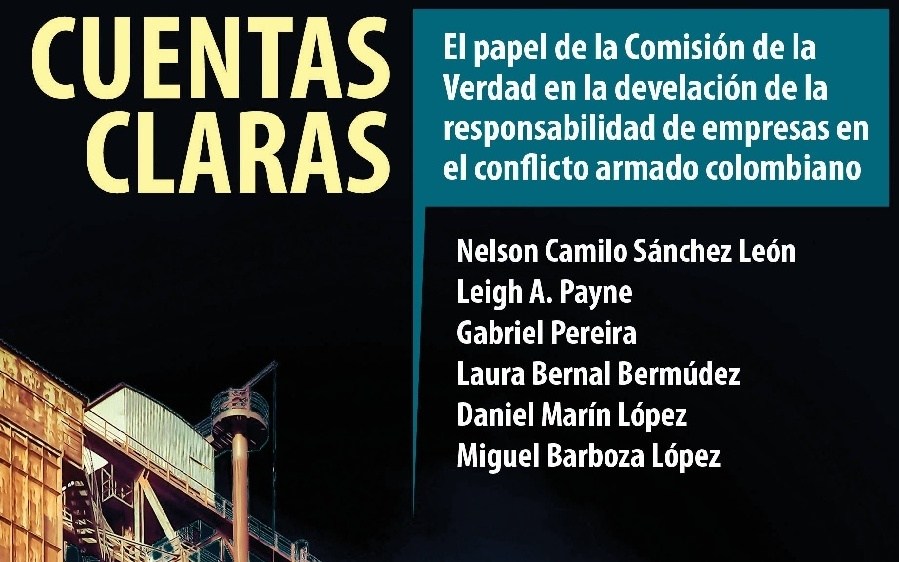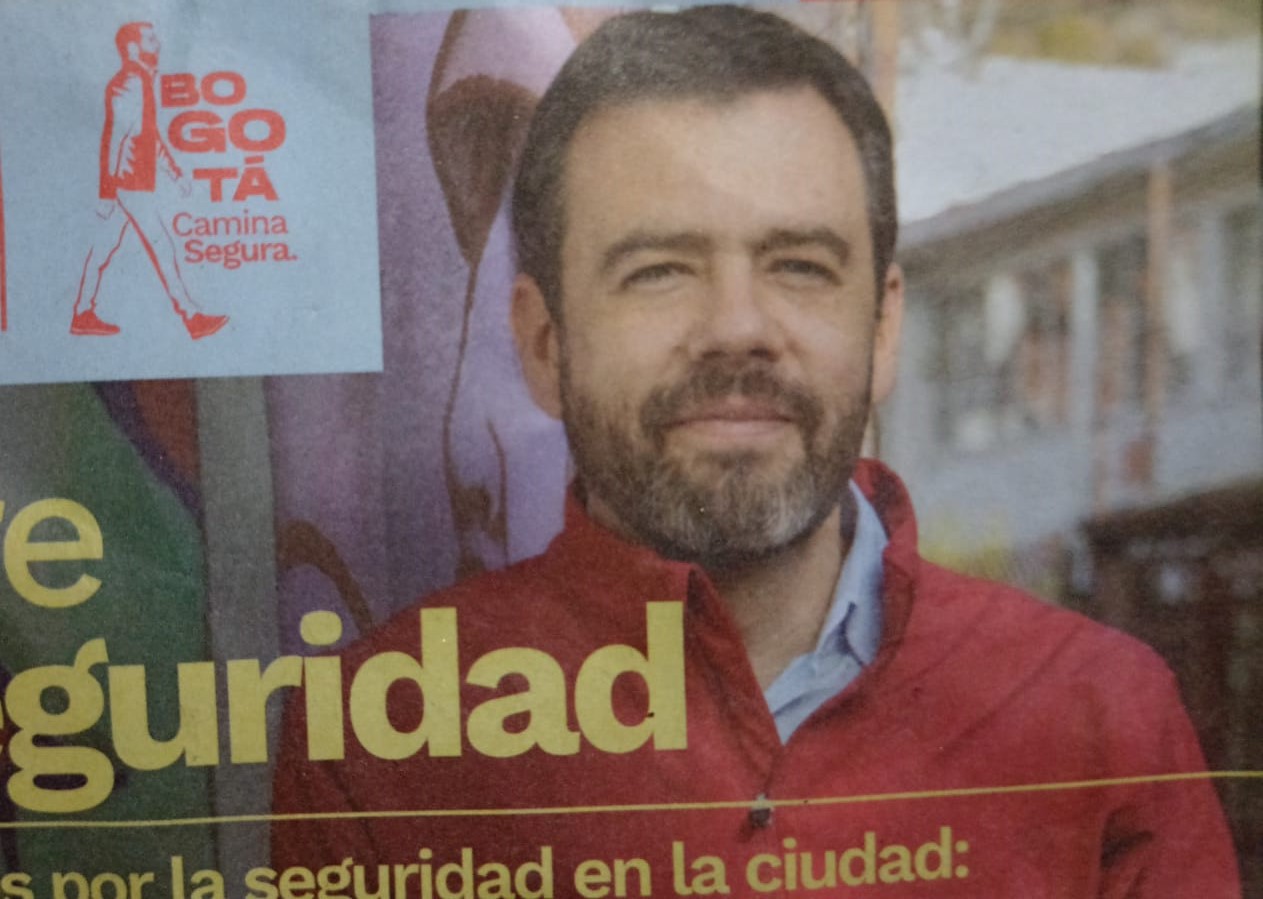
Colombia’s high human cost of the war on drugs: soldiers’ graves in Bogotá.
Cocaine cash continues to fuel conflict in Colombia and it is often the rural communities that pay the price. In tackling a global problem that has been decades in the making, there are no quick fixes.
Many rural communities remain plagued by violence, in spite of the peace agreement with the FARC. This reveals the endless tussle over cocaine, both its production and distribution, to be the true cause of conflict in Colombia. Yes folks, the leftist guerrillas were just a side-show: the large powdery-white elephant in the room is the USD$300 billion-per-year global illicit drug business anchored in Colombia. As Bill Clinton might say, ‘It’s the narco-economy, stupid.’
Of course, the former guerrillas were up to their armpits in drugs and many predicted that once the FARC resigned its role as overseer-in-chief of large swathes of cocaine-producing zones of Colombia, other gunslingers would step in to fill the gap. And there would be blood.
 With reason, then, some Colombians doubted the peace process. ‘Más vale malo conocido…’, better the devil you know, as one colleague put it to me. On their home ground the FARC had some ideology and restraint. The bunch filling their shoes could be a lot worse.
With reason, then, some Colombians doubted the peace process. ‘Más vale malo conocido…’, better the devil you know, as one colleague put it to me. On their home ground the FARC had some ideology and restraint. The bunch filling their shoes could be a lot worse.
These new gangs are now called GAOs, (Grupos Armados Organizados) – formerly known as BACRIM (bandas criminales) – armed groups with leadership and hierarchy who launch attacks on both state armed forces and civil society (and frequently each other). According to the government they ‘lack any type of ideology’ and have purely criminal ends.
Related: The writing’s on the wall
But just as the ideological FARC drifted into drugs, large drug gangs have drifted into de facto governance of the areas they control. Groups like the Gaitanistas (AGC), La Gente del Orden, Los Pelusos and Los Puntilleros all claim some higher social goal that goes beyond filling the world’s seeming insatiable desire for cocaine.
This stems from their distant ideological roots, either in right-wing paramilitarism or dissident guerrilla groups, but also in how cocaine is made; it uses coca leaves cultivated by campesino communities in small plots over a large rural area, and this zone demands tight control by the drug gangs through the time-honoured tradition of plomo o plata: cooperate and get paid, or resist and be killed.
Establishing state presence
In their belligerent phase, the FARC did the drug trade a favour by sealing off large areas of Colombia where coca production could go on unhindered. One key part of the peace process was for the state to reoccupy these areas and assist farmers to replace the coca with legal and marketable crops.
“They missed the ball on that one. State control was too little, too late and new armed groups took over, or the old fighters just changed uniforms,” says a friend who works in rural areas, an opinion echoed by many observers. Meanwhile, coca cropping has soared in the last two years, leaving President Santos in the uncomfortable position of signing a peace treaty while illegal drug production – the main driver of conflict in Colombia – reaches a new high.
No wonder most of the murders of social leaders in the last two years – more than 150 at the last count – have taken place in former FARC zones and coca-growing areas, says a recent report by Colombian rights group Indepaz. It also points out problems with the Peace Accord plan to engage communities in promoting coca crop substitution. In practice this puts local leaders in the cross-hairs of drug gangs who want more, not fewer, of cocaine’s raw materials.
In fact, many drug gangs won’t allow farmers to stop growing coca, and there are many stories from rural communities who are coming under attack for trying to switch to coffee or cacao. Since corruption in state forces has led some troops to secretly plot with the drug gangs, who can the farmers trust?
To add fuel to the fire, the state has ramped up the forced eradication of crops using armed anti-drug police backed by the feared ESMAD anti-riot units – often in the same areas where substitution was supposed to start. This went badly wrong in October when police shot dead seven protesting farmers in the rural area of Tumaco.
Many see this massacre as the predictable outcome of US pressure on Colombia to forcibly eradicate coca fields. The US is opposing the substitution plan, having declared it null and void because it was part of a peace deal with the FARC, which in their minds is still a narco-terrorist organisation (despite the fact it has demobilised).
Behind this posturing, the US suspects that the softly-softly approach of crop substitution will be ineffective, like a slow-motion game of whack-a-mole as coca springs up in new areas even while old plantations are slowly replaced with papaya. They also worry that some crafty campesinos will grow coca just to get the substitution benefits.
Some see the US refusal to back substitution schemes as payback for the Colombian government’s decision in 2015 to suspend aerial spraying of glyphosate herbicide (a lucrative business for US defence contractors). True, spraying from planes did reduce coca crops but it also wreaked havoc on legitimate crops, neutralising the benefits of crop substitution, and since glyphosate is a suspected carcinogen, it is unlikely to come back.
Manual eradication
This leaves sending heavily-armed eradication teams to manually uproot coca plants as the only quick-fix coca solution. This is a gruelling task in hostile territory where troops risk landmines and surprise attacks as they labour under a hot sun, exactly the scenario that can lead to on-edge combatants opening fire if they feel under threat.
 Legally, state forces can use lethal force against suspected GAO fighters and effectively engage them in combat, or even use snipers to shoot them dead. But the gangs will fight back and, like their guerrilla and paramilitary predecessors, camouflage themselves among civilians. The outcome is a nightmare for campesinos caught between gangs forcing them to grow coca (and protest its eradication) and trigger-happy state forces sent to eradicate.
Legally, state forces can use lethal force against suspected GAO fighters and effectively engage them in combat, or even use snipers to shoot them dead. But the gangs will fight back and, like their guerrilla and paramilitary predecessors, camouflage themselves among civilians. The outcome is a nightmare for campesinos caught between gangs forcing them to grow coca (and protest its eradication) and trigger-happy state forces sent to eradicate.
And while it may seem logical to stop cocaine by (literally) cutting it off at the roots, some economists argue controlling coca is a waste of time. This is because USD$650 of locally-grown leaves can be converted into 1 kilo of cocaine worth USD$7,000 in Colombia, but USD$100,000 in New York. With such a huge profit to be made overseas, there will always be excess cash to create relatively cheap coca plantations, no matter what the human or environmental cost.
How much is the overall cocaine trade worth? No-one can say for sure in a business that is necessarily clandestine and constantly evolving, such as increases in cocaine yield per coca hectare. One estimate states that 97% of Colombian cocaine profit stays overseas, mostly in consumer countries, to be laundered through crooked business and banking systems. Only 3% makes it back to Colombia.
Still, even this small percentage adds up to around USD$10 billion flowing back to Colombia’s criminal enterprises – more cocaine, illegal mining etc – and more conflict. A large chunk also washes into mainstream businesses, often ending up in the hands of the country’s elite.
These figures also reveal the biggest underlying injustice of it all: Colombian peasants face bullets and endless cycles of violence while overseas, the directors of money-laundering banks get suspended sentences and fines. Even large players like the Bank of New York and Bank of America have been caught washing cocaine cash over the years.
Time for a rethink
Perhaps that’s why President Santos used his Nobel Peace Prize acceptance speech to push his argument that, “The manner in which this war against drugs is being waged is equally or perhaps even more harmful than all the wars the world is fighting today, combined.” He has regularly called on global leaders to “rethink” the strategy, the sub-text being ‘stop picking on Colombia’. His government is taking steps to decriminalise small-scale coca leaf production, which also avoids the thorny issue of having to lock up 100,000 campesinos. Colombian jails are already a long way past full.
But can he get crop substitution back on track? It seems to be a mammoth task, because it is not just about switching crops, but also creating a whole infrastructure of governance and security in the campo, something Colombia has historically been very bad at.
It is going to need a paradigm shift in military thinking for a start. After years of being ambushed by guerrillas, state troops understandably see many rural areas as hostile, and are more used to fast-in, fast-out counter-attacks than a protective role with permanent presence.
It will also need a lot of resources and right now the cupboard is bare. This prompted the call last month by the International Crisis Group (see the side story about the ICG report) for the international community to step in and fund crop substitution, either directly or by complementary projects which give the state a benign presence in former FARC areas.
Related: ICG: Overseas aid is key to reducing crisis in Colombia
But even with funds, can long-term substitution survive the rough and tumble of the coming elections? Already the signs are that tub-thumping politicos will roll back the peace agreements and preach a Rambo response to coca control.
“So, to get themselves elected they’ll condemn another generation to war while their own kids live in Miami,” mutters my friend who works in the campo. In his mind the urban elite pushing hardest for a ‘war on drugs’ stand to gain most from the ensuing violence. “The shit flows down while the money floats up,” he declares. Meanwhile, the equation holds true that coca needs conflict, and conflict needs cocaine. Breaking that will be mighty hard.
By Gerald Barr. This article first appeared in Edition 49 of The Bogotá Post.





